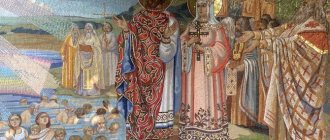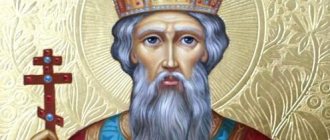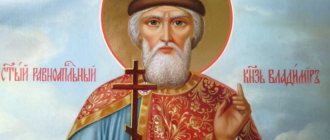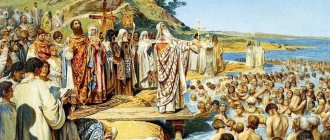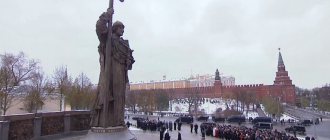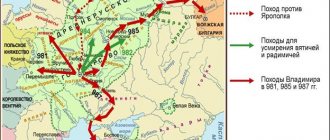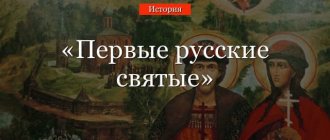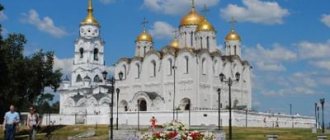“Volodimer sent an ambassador throughout the city, saying: “If anyone does not appear in the morning at the river, whether rich, or poor, or poor, or a worker, let him be disgusted with me.” Hearing this, the people walked with joy, rejoicing and saying: “If this had not been good, the prince and the boyars would not have accepted this”…” - this is how the author of “The Tale of Bygone Years” described the baptism of the Kievites. In a single impulse, the residents of the capital, following the example of their benefactor-prince, stepped into the waters of the Dnieper and abandoned their pagan past. However, the reality turned out to be not as rosy as the chronicler outlined in his work. Before completely conquering the minds of the inhabitants of the state, Christianity had to fight with paganism that was still afloat.
Pagan beliefs of Rus' before the adoption of Christianity
By the end of the 10th century, Kievan Rus stretched from the Baltic Sea to the Black Sea and from the Bug to the Oka. From the West, Rus' bordered on Catholic Poland and Hungary, from the East - on Muslim Bulgaria, from the South-East on Jewish Khazaria, from the South - on Orthodox Byzantium. Rus' remained pagan.
The collection of gods of Ancient Rus' included more than a dozen Elder gods and even more Younger ones. These included the spirits and guardians who inhabited all areas of the lives of our ancestors. Spirits lived everywhere: in the house, barn, forest, river. They were the ones who were responsible for the harvest, success in hunting, and the well-being of the family. They brought demands, asking for help in all matters, from the fateful to the daily. The prince and his squad (Perun), the cattle breeders (Veles), the women (Mokosh), etc. had their own gods. Many gods were similar to the deities of their neighbors - the Baltic, Western and Southern Slavs.
Religion of the states surrounding Ancient Rus'
Rus' was surrounded by countries that had already adopted one of the world religions. So Poland in 966, during the reign of Prince Mieszko from the Piast family, was baptized according to the Latin rite. The Hungarian prince Istvan in 1000 accepted the crown of the Christian king from the hands of Pope Sylvester II. The Bulgarian kingdom converted to Islam in 922 under Tsar Almas. The top of the Khazar Khaganate, living out the last decades of its existence under the blows of the Russian princes, professed Judaism. But the most powerful state in the region was the Orthodox Byzantine Empire.
In all newly converted states, religion penetrated through ruling dynasties and groups. It was they who needed unified state religions, which were supposed to unite tribal unions into single powers and sanctify the power of the ruler.
Prince Igor the Old and Christianity
The reign of Igor the Old was also associated with campaigns against Constantinople, although less successful compared to Oleg the Prophet. If in the Russian-Byzantine treaties of Prince Oleg there is no mention of Christians, then in the treaties of Prince Igor there are phrases about “baptized” and “unbaptized” Russians who do not dare to violate their obligations to the Greeks. When ratifying treaties, the parties to the agreements swear: Christians - in churches, and pagans in temples. This suggests that a significant portion of Prince Igor’s retinue were Christians. However, Igor the Old was unable, or did not have time, to introduce Christianity as the state religion of Rus'. Igor did not make a noticeable contribution to the Christianization of Rus'.
The first historical facts of the baptism of the Slavs
Rus' was no exception. The first reports of the adoption of Christianity date back to the end of the 8th century, when, according to the Byzantine source “The Life of St. Stephen of Sourozh,” an army of Rus under the command of Prince Bravlin took Sudak (Sourozh). According to legend, the prince was punished by God with illness for plundering the city. In order to be saved, he accepted the Christian faith.
Historians claim that the predecessors of Oleg and Igor on the Kiev throne, princes Dir and Askold, were Christians. They were baptized “with the boyars” after the campaign against Constantinople.
The first ruler of Rus' Rurik and Christianity
It is generally accepted that the arrival of Prince Rurik in Rus' is the beginning of Russian statehood. The legendary personality of the first ruler of Rus' is shrouded in secrets, so it is very difficult to determine his attitude towards Christianity. There is evidence linked to the Xanten annals that in 826 a certain Rurik (the son of a Danish king) was baptized with the participation of the Frankish king Louis the Pious. Was it Rurik of Novgorod (Varangian)? It's impossible to say for sure. It is impossible to say anything definite about Rurik’s attitude to the introduction of Christianity in Rus'.
The first Russian saint
The first Russian saint and the first ruler to convert to Christianity of the Byzantine rite was Princess Olga. In 957 she visited Constantinople. She was personally baptized by Emperor Constantine VII Porphyrogenitus and Patriarch Theophylact. She was given her baptismal name Elena. There is a beautiful legend associated with the ritual. According to her, Emperor Constantine admired Olga's intelligence and beauty and wanted to take her as his wife. But she objected that, being a pagan, she could not become his wife and asked to baptize her. When he baptized her and again started talking about marriage, Olga replied that she was his goddaughter, and therefore could not marry him. Admired by her sharp mind, the emperor rewarded the princess and sent her on her way.
After Olga's baptism, Orthodoxy gradually spread among the population of Ancient Rus'. This is confirmed by archaeological finds.
At the beginning of the 13th century, Olga was canonized, and in 1547 she was canonized as Equal-to-the-Apostles.
Ruler Olga is a saint
Princess Olga is the first verified Christian ruler of Kievan Rus. Baptized by the Byzantine Emperor and the Patriarch of Constantinople, the Kiev ruler patronized Russian Christians. However, there was no talk about the introduction of Christianity in Rus' as a state religion. Some of those close to her followed her example, but this did not affect the general commitment to the paganism of the Russians. Her contribution to the introduction of Christianity into Russian religious life was truly outstanding.
The Legend of the Choice of Faith
In 980, Prince Vladimir won the war of succession and established himself on the Kiev table. Then he made an attempt to create his own pantheon of pagan gods - Vladimir’s temple. This didn't have much effect. People continued to worship their old gods.
According to the Tale of Bygone Years, all confessions sent their envoys to Prince Vladimir.
Mohammedans
The first were Muslims from Volga Bulgaria. They exhorted the ruler of Rus' to accept Islam, promising the caresses of the beautiful Gurias in the afterlife. But strict restrictions on food and drink (no pork and wine) and the need to undergo circumcision turned out to be unacceptable. The chronicle quotes Prince Vladimir as follows:
“Rus' drinks joy, we cannot live without it”
Catholics (Latins)
Next came the envoys of the Pope (Germans from Rome […] messages from the Pope”). It should be noted that the final, Great Schism into the Roman Catholic Church in the West and the Orthodox Church in the East, centered in Constantinople, occurred later in 1054. But already at the end of the 10th century, these were actually two churches opposing themselves to each other. Obviously, this was not the first visit of Christians of the Western rite to Rus'. The prince’s refusal is recorded in the chronicle as follows:
“Go again, because our fathers did not accept the essence of this”
Jews
Having learned about the failure of their predecessors, Jews from the Khazar Kaganate (Jewish kozarstiya) arrived in Kyiv. The attempt was obviously a failure, because it was the vanquished who accepted the religion of the victors, and not vice versa. And the Kaganate collapsed under the blows of the Russians. Vladimir's father Svyatoslav not long ago devastated Khazaria. Vladimir himself fought with them in 985 and imposed tribute on them. The prince asked the Jews where their lands were. They answered that God was angry with them and scattered them among the nations. Vladimir was indignant: how can they teach others if they themselves are rejected by God. Or do they want the same fate for his people?
Orthodox
In contrast to the delegations of other faiths, the Byzantine priest is shown as a lonely philosopher. But he captivated the prince with a retelling of the Old and New Testaments, answered all questions about faith and amazed him with his eloquence. The philosopher also showed Vladimir a colorful picture of the Last Judgment.
“Good for the righteous, woe for the sinners!” - said the prince.
“Be baptized, and you will be in heaven with the first,” answered the Greek preacher.
Prince Svyatoslav, true pagan
Svyatoslav, raised by the devout pagan Sveneld, upon coming to power, destroyed the Church of St. Nicholas (later restored). Perhaps his camp life was determined by the desire to be away from Kyiv, where baptized boyars were in charge, from his mother’s entourage. His attitude towards Christianity did not change until the moment of his tragic death. Svyatoslav’s contribution to the introduction of a new religion can be considered that he, due to his isolation from his homeland, did not greatly interfere with the process of Christianization in Rus'.
"Test of Faith" by Vladimir
After listening to all the envoys, the prince sent ten people “kind and sensible” to the Latins, Mohammedans and Greeks to test their faith and service. When they returned, Vladimir ordered: tell the squad. The envoys criticized the Bulgars and Latin Germans. But they spoke very well of the Greek faith, and said: “Whoever has tasted sweet things will not accept bitter things.”
Volodymyr, speech: “Where shall we receive baptism?” They decide: “Where are you?”
The question of choosing a place was not unimportant: going to Constantinople as a petitioner meant putting oneself in a dependent position in advance. The Greeks themselves were in no hurry to baptize him in Kyiv. The decision was made simple, but effective - Vladimir gathered an army and took Korsun (Byzantine Chersonese).
How to visit the place of baptism now, traditions
In order to celebrate the date at the origins of Orthodoxy, you need to go to Chersonesos, which is now located on the territory of Sevastopol, in Crimea. On this day, July 28, a big holiday is held there, concerts are held, prayers are read. Those present thank the Lord that He showed the way to the Russian state and led everyone to Orthodoxy. The Sretensky Monastery plays an important role in the celebration.
Baptism in Korsun
There are two versions of the Russian army’s campaign against Chersonesus. According to one of them, Vladimir, as a loyal ally of the Byzantine basileus Basileus II the Bulgarian-Slayers, returned the rebellious city to his hand. Chersonesos joined the uprising of the commander Bardas Phocas, broke away from Byzantium, and the capture of the city was not a war with the basileus, but, on the contrary, help against the rebels.
According to another version, Vladimir really helped Vasily II in the internal war against Varda Phokas, for which he sent an army of 6,000 soldiers. In exchange, he was promised an alliance and dynastic marriage with the emperor's sister, Princess Anne. This union put him on the same level as the Byzantine basileus. But the emperor was in no hurry to fulfill his obligations. Therefore, the Russian army captured Korsun to demonstrate the seriousness of its intentions.
Be that as it may, after the capture of Korsun, Vladimir waited for Anna with the churchmen and was baptized. After which he got married and went to Kyiv. Leaving Chersonesos, he took out all the icons, utensils and relics of saints, as well as Greek copper statues. But he left behind the Church of St. John the Baptist.
Vladimir Svyatoslavich and the baptism of Rus'
Vladimir Yaroslavich, who won the internecine war, did not initially plan to spread Christianity to Rus' - baptism was preceded by an attempt to unify pagan cults in the lands controlled by Kyiv. Perun was declared the supreme god, and pagan temples were erected. But the reform did not achieve the desired result: the unification of the lands was hampered by the variety of cults, not all of which recognized the supremacy of Perun. It was then that Vladimir thought about converting to one of the monotheistic religions. [Collection: Vladimir the Holy]
In the chronicles, these thoughts (or, rather, ideas about them) were reflected in the legend of the “Test of Faith.” Of course, in reality, there were no clergy embassies to Vladimir’s court in a short period of time, but the legend quite reliably conveys the atmosphere in which Vladimir was forced to make a decision about the spiritual future of his subjects. The choice fell on Byzantine-style Christianity - Rus' had long had fairly close contacts with the Eastern Roman Empire. [Collection: Byzantium]
There is still debate in historical scholarship regarding the specific time of the baptism of Vladimir and the people of Kiev. The generally accepted date is disputed by scientists: many researchers date the prince’s conversion to Christianity to 987, and the events in Kyiv to 990. However, the main events are not controversial. Vladimir's support of Constantinople in the fight against the uprising of Bardas Phocas, his courtship to Princess Anna and the siege of Korsun really happened. As well as sending missionaries to the capital of Rus'.
Arrival of Byzantine missionaries in Kyiv. Source: wikipedia.org
The idyllic picture of the baptism of Kiev residents also raises doubts. Thus, church history researcher Oleg Rapov points out that not all residents of the capital agreed with the changes in the spiritual life of the state. Many supporters of paganism, as a sign of protest against the princely policies, left the city for the forests and actively resisted the introduction of Christianity. Events in Kyiv clearly showed that the Christianization of Rus' would last for many years and would be accompanied by violent clashes in an attempt to protect pagan temples and the right to practice pagan cults.
Destruction of the Kyiv temple, baptism of the people of Kiev
Returning to Kyiv, Vladimir ordered the destruction of the temple, which he himself had erected in 980. And if he ordered the idols of Khors, Dazhdbog, Stribog, Semargl and Mokosha to be chopped up and thrown into the fire, then Perun was especially punished. By the will of the prince, he was tied to the tail of a horse and dragged to the river, beating him with sticks. The people detached by Vladimir went down to the Dnieper rapids, preventing the idol from landing on the shore. Thus, he was symbolically expelled from Rus'.
Victor Vasnetsov. Baptism of Rus'. 1885-1896
Having dealt with the former gods, Vladimir ordered the people of Kiev to come to the banks of the Dnieper for Baptism:
“If anyone does not come to the river tomorrow - be it rich, or poor, or beggar, or slave - he will be my enemy.”
According to the chronicle, the majority of Kiev residents happily came to the Dnieper, saying that if the Greek faith were bad, the prince and the boyars would not have accepted it. In addition, the Christian community of the city was already large by that time.
Holy Baptist of Rus' Prince Vladimir Svyatoslavovich
The name of Prince Vladimir the Saint is one of the most significant in all of Russian history. Already in ancient Russian chronicles he was called equal to the apostles. An ardent pagan in his youth, who stained himself with many unseemly actions, the prince came to accept Christianity in adulthood. In him he saw not only (and not so much) the salvation of his soul, but a true benefit for the state under his control. It was Prince Vladimir who made a fundamental contribution to the introduction of Christianity in Rus'. His heirs only strengthened Christianity as the state religion.
Baptism of Veliky Novgorod
The next important center of Rus' was Mister Veliky Novgorod. It was the largest city of northern Rus', the first capital of Ancient Rus' of the Rurikovichs. There was also an important economic aspect - it was the northern gateway of the route “from the Varangians to the Greeks.”
Christian communities have existed in Novgorod for a long time. They lived peacefully with the bulk of the pagan population. But the Novgorodians, taught by the Magi, did not want to be baptized by the will of Kyiv. Therefore, Vladimir sent an army with priests, led by his uncle, the governor Dobrynya and the thousand-man Putyata. The church mission was headed by Joachim Korsunyanin.
Baptism was accompanied by “evil flogging.” Despite the numerical superiority of the Novgorodians, Putyata managed to decapitate the uprising. And when Dobrynya set fire to the city, the pagans asked for peace. Since then they have said about the baptism of Novgorod:
“Putyata baptized with a sword, and Dobrynya with fire”
Prince Yaropolk Svyatoslavovich unrealized prospects
During the six years of his reign, Yaropolk Svyatoslavovich intensified diplomatic ties with Otto II, the German emperor, and married the daughter of his close relative. The Nikon Chronicle testifies to Yaropolk's reception of ambassadors from the Pope. The Joachim Chronicle says that Yaropolk sympathized with Christians and gave them “freedom
great." There are historical versions about the baptism of Prince Yaropolk. In any case, Prince Yaropolk contributed to the creation of conditions for the introduction of Christianity in Rus' as a state religion.
The baptism of Russian cities and the establishment of a church organization in Rus'
After the baptism of the two main centers of Rus', Christianity spread to other lands and cities. In 997, the Kiev metropolis was established, subordinate to the Patriarchate of Constantinople. It included the dioceses of Novgorod, Rostov and Suzdal, Chernigov and Novgorod-Seversk, Vladimir-Volyn and Kovel, Polotsk and Glubokoe, Turov and Mozyr.
The first bishops and metropolitans of Rus' were Greeks; liturgical books in Old Church Slavonic were brought from Bulgaria. The first stone temples were built by craftsmen invited from Byzantium. In 990, the first cathedral of Rus' was founded - the Church of the Tithes. It was built by Greek and Russian masters over the course of 6 years. It got its name from the fact that the prince allocated a tenth of his income (tithe) for its maintenance.
How Christianity was chosen in Rus'. Reference
In 983, after a successful campaign, Vladimir decided to make a human sacrifice to his pagan gods. It was decided to choose a victim using a lot, which fell on the young man John. The young man's father Theodore, who was a Christian, did not want to give up his son and began to condemn pagan idols and glorify the Christian faith. An angry crowd of pagans killed Theodore and his son. These were the first Christian martyrs in Rus'; The memory of the holy martyrs Theodore and his son John is celebrated on July 12 (25).
This case of public condemnation of the pagan gods made Prince Vladimir think about the truth of his pagan faith.
The chronicle story about the “choice of faiths” (“test of faiths”) by Vladimir is a kind of legend. As the chronicles tell, embassies from different nations came to the prince in Kyiv in 986, calling on Rus' to convert to their faith. First, the Volga Bulgarians of the Muslim faith came and praised Mohammed; then foreigners from Rome preached the Catholic faith from the pope, and Khazar Jews preached Judaism. Vladimir did not accept Judaism - he did not like the fact that for their sins the Lord scattered the Jews throughout the earth. Vladimir did not like the faith of the Mohammedans (Volga-Kama Bulgarians) because of the dryness of their worship, with their interpretation of the afterlife, about wives and the prohibition of drinking wine. In 962, at the request of Princess Olga, the German emperor sent a bishop and priests to Kyiv, who were not accepted by the prince.
The last to arrive was a preacher sent from Byzantium. He began to tell Vladimir about Orthodoxy, and Vladimir listened to him with all attention. At the end, the Greek showed the prince a cloth on which the judgment seat of the Lord was depicted. On the right stood the righteous, going to heaven in joy, and on the left were sinners going to torment. Vladimir, sighing, said: “It’s good for those on the right, and bad for those on the left.” “If you want to stand on the right side of the righteous, then be baptized,” said the Greek. But Vladimir answered: “I’ll wait a little longer,” wanting to find out more about all the faiths.
Tradition says that Prince Vladimir, in order to test on the spot whose faith is better, sent nine envoys. When the Russian ambassadors were in Constantinople, the splendor of the St. Sophia Church, the harmonious singing of the singers, and the solemnity of the patriarchal service touched them to the depths of their souls. They later told Prince Vladimir: “We didn’t know whether we were standing on earth or in heaven.” The boyars listening to this said: “If the Greek faith had not been better than other faiths, then your grandmother Olga, the wisest of people, would not have accepted it.” And the ambassadors said: “And just as someone who has tasted sweet does not want bitter, so we do not want to remain pagans anymore.”
However, Vladimir did not immediately accept Christianity. In 988, he captured Korsun (Chersonese in Crimea) and demanded Anna, the sister of the Byzantine emperors Basil II and Constantine VIII, as his wife, threatening otherwise to go to Constantinople. The emperors agreed, demanding in turn that the prince be baptized so that his sister could marry a fellow believer. Having received Vladimir's consent, the brothers sent Anna to Korsun. There in Korsun, Vladimir and many warriors were baptized by the Bishop of Korsun, after which they performed the wedding ceremony. At baptism, Vladimir took the name Vasily, in honor of the ruling Byzantine emperor Vasily II.
Returning to Kyiv, accompanied by Korsun and Greek priests, Vladimir first of all baptized his twelve sons. They were all baptized in one spring, known in Kyiv as Khreshchatyk. Following them, many boyars were baptized.
And on the appointed day, a mass baptism of Kiev residents took place at the confluence of the Pochayna River into the Dnieper. The chronicles read: “The very next day, Vladimir went out with the Tsaritsyn and Korsuin priests to the Dnieper, and countless people gathered there. They entered the water and stood there, some up to their necks, others up to their chests, small children near the shore up to their chests, some holding babies, and adults wandering around, while the priests performed prayers, standing still...” This most important event took place, according to the chronicle chronology, in 988. Following Kiev, Christianity gradually came to other cities of Kievan Rus: Chernigov, Novgorod, Rostov, Volyn, Polotsk, Turov, Tmutarakan, where dioceses were created. Thus, under Prince Vladimir, the overwhelming majority of the Russian population accepted the Christian faith, and Kievan Rus became a Christian country.
Having adopted Christianity, Prince Vladimir began to carry out the covenants of Christ. All over Rus' they began to provide assistance to the poor and sick. Vladimir contributed to the spread of Christian education in Rus', built new cities, and erected churches in them. St. died book Vladimir on July 15, 1015 and was buried in the Tithe Church in Kyiv.
The material was prepared based on information from open sources
All inquiries>>
Riots of the Magi and dual faith
Paganism retreated before Christianity slowly. So even in Novgorod, baptism took place in three stages. The Novgorodians pretended to be baptized, but secretly worshiped the old gods. Then Dobrynya obliged everyone to wear crosses.
Christianity remained the faith of the cities; in remote villages, paganism persisted for centuries. Until the 12th century, the so-called uprisings of the Magi broke out. Already in 1534, Metropolitan Macarius complained to Ivan the Terrible that even under his father Vasily Ivanovich.
“In many Russian places, nasty idolatry prayers were preserved”
Orthodox Christianity is a gift from God to Holy Rus'
The Baptism of Rus' around 989 was the act of introducing Christianity as the state religion, the spiritual basis of the multinational people inhabiting it. This step was important not only for our Fatherland, but above all, it had world-historical significance. The subsequent history of the Russian state showed the enormous positive role of Orthodox Christianity in the formation, survival, revival and strengthening of the country in various life situations. The contribution of the first rulers of Rus' to the introduction of Orthodoxy in Rus' is valuable, but to varying degrees.
